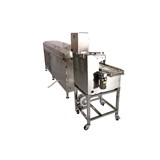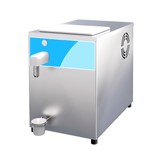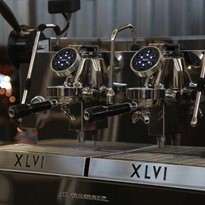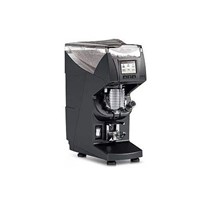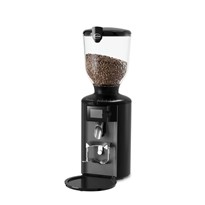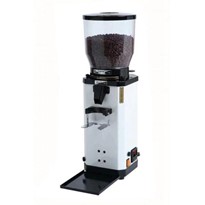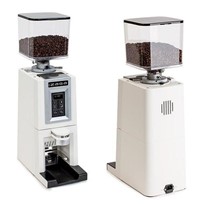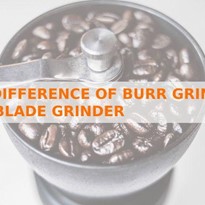In the 20th century, the coffee industry experienced an evolution from percolator-style to the drip method of coffee brewing. Now in the 21st century, we are seeing the development of other sophisticated brewing technologies around the world.
To meet these technological developments and demands, coffee grinding has evolved as well.

The first coffee grinder, dating back to the origins of coffee, was the mortar and pestle. People in Ethiopia, the Middle East, and early coffee drinking countries would use the small club and bowl to grind up coffee beans for brewing.
While the mortar and pestle is still a popular device to create powders and pastes, this method proved impractical and inconsistent as coffee consumption took off around the world. In the 15th century, people used their manual spice grinders or grain mills to grind coffee.
The first coffee mill, made specifically to grind coffee beans, was invented by Englishman Nicholas Book in the late 17th century. Coffee was placed in the top of the lever device and was grinded into a bottom drawer.
Thanks to its success, many other inventors and companies put out their own manual devices throughout the 18th century. These were household items until the late 1800s, when American company Hobart produced the first electrical coffee grinder, leading a shift towards the grinders we know today.

Since then, developments in coffee grinding continued, but in less obvious ways. Burrs were made with new materials, improving their performance. Weights for measuring coffee output were introduced. Slight design changes were made to improve workflow.
In the last decade or so, as the specialty coffee scene took off and customer expectations rose, new technologies were implemented into coffee grinders to improve quality and ensure consistency such as the Mazzer Grinder below.

Some of these new developments include:
Real-time grinding. This is achieved using a laser analyser to continuously check coffee while the grinder is operating and automatically adjusting, as necessary, to accommodate optimal grind requirements. Real time notifications can alert the user of worn burrs or the need for a general service.
Bluetooth-enablement. The grinder-doser, connected to the espresso machine via Bluetooth, provides constant control of coffee-dispensing parameters and automatically carries out any grinding and dosing corrections to ensure optimal, constant dispensing.
Touchless coffee grinding. An integrated system can ease the work of the barista by maintaining a dialogue between the machine and grinder-doser.This technology guides the barista step-by-step through each beverage preparation stage, from grinding to dispensing. Some grinders enable the on-demand, wireless grinder-doser to identify the coffee dose to grind (single or double), to dispense it, and communicate this to the machine. This enables the machine to only allow the correct recipe to be selected.
Intelligent grinding. This total grinder automation technology includes not only the monitoring and measuring of every aspect of a coffee grind, including density and temperature, but also the adjusting of the grinder to automatically maintain the desired specification.
Thermal stability systems, like those featured in the Mythos One grinder. This gives maximum consistency to each dose. It guarantees constant temperature in the grinding chamber and therefore better-quality espresso extraction, giving greater flexibility and efficiency.
Wi-Fi connectivity. Wherever you are, you can connect to the grinder through the cloud. Grinder data is remotely and easily accessible by the barista, coffee roaster, business owner, or service agent. Operators can monitor any and all grinder outputs, keep up with maintenance needs, and improve coffee quality using data tracked by the grinder. This is a key component of the Mazzer Robur S grinder.
Anti-clump crusher technology. This sits between the blades and the funnel and acts as an anti-static barrier. It allows the dose to pour out cleanly, with no spray, which results in reduced wastage. Eureka grinders make great use of this technology.

'
Developments in grinder technology have improved versatility as well as consistency and quality. Burrs come in all shapes and sizes, each offering different benefits. Two of the most common types of burr blade shapes are conical and flat.
Conical blades, shaped similarly to a cone, sit closely inside one another. The coffee bean is broken down as it moves between both of the burrs. Conical blades often feature low retention and are popular in hand grinders or for domestic use.
Flat blades sit parallel to one another while the coffee beans travel between them. Flat burr grinders provide better control and are popular in cafés.
Grinder burrs can also be made of different materials, each suited to different budgets and requirements. These include:
Hardened steel. This is the most common type of blade found within a grinder and is the standard with most grinder makes and models. It is used as an all-rounder for grind efficiency and cost effectiveness.
Ceramic. Ceramic blades are a great alternative to metallic blades. However, one issue is that they don’t do well with blunt impact or foreign objects, such as a hopper screw. If these come into contact with a foreign object during grinding, expect them to break or shatter.
Titanium. Blades of this material have a far longer lifespan than standard hardened steel blades and don’t heat soak as quickly. The downside is that they are more expensive than the standard steel option.
Red Speed. Red Speed blades are a combination of titanium and aluminium. They are intended for high volume accounts and have an extended grinding life. Red Speed blades are also far more resistant to heat soaking.
Diamond Inside. Diamond Inside is a patented process for thermal cryogenic treatment of burrs at -193°C. This results in the formation of an increased crystal structure that guarantees a superior wear resistance and duration.
Diamond Inside is able to preserve the optimal geometry of the sharpening longer than any other burr typology. This keeps the granulometry constant for an exceptionally high quantity of ground coffee, around 1300 kilograms with burrs of 65 millimetres. The total duration can reach up to 1500 or 1600 kilograms.
In many ways, grinders are just as advanced, complex, and evolved as espresso machines and brewing equipment. As the industry’s knowledge continues to grow, coffee grinders will keep developing to produce even better coffee. Coffee grinders have come a long way since the mortar and pestle.

For more information contact Chione today. We take a very direct, informed and objective approach. We believe success in business comes from personal communication and making that connection by establishing the clients’ needs and expectations up-front.



-160x160-state_article-rel-cat.png)



-160x160-state_article-rel-cat.png)








